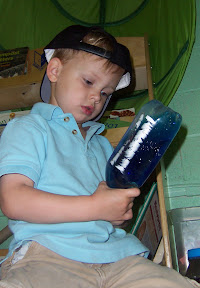Discovery bottles
By Peggy Ashbrook
Posted on 2009-09-17
 All summer I was getting ready for the upcoming school year by collecting clear plastic jars and bottles with screw-on lids. Now they are on the shelf at school as “Discovery Bottles”, compact and beautiful, and (best of all) contained. (Click on the photo to view more photos of Discovery Bottles and other early childhood science activities.)
All summer I was getting ready for the upcoming school year by collecting clear plastic jars and bottles with screw-on lids. Now they are on the shelf at school as “Discovery Bottles”, compact and beautiful, and (best of all) contained. (Click on the photo to view more photos of Discovery Bottles and other early childhood science activities.)
These containers hold objects that engage children’s interest and provide the materials needed to explore a topic such as magnetism, bubbles, or buoyancy. With a sealed lid small items stay inside, safe for young children and kept together to illustrate a concept such as liquids can float on top of other liquids (have different densities), some objects float and others sink, and different shapes move (fall) through liquids in different ways as they sink.
Here’s what I put in one:
 Water tinted blue with food coloring, clean sand, small shells, sea glass, a key, and a few coins, and mineral oil. I wanted something to float at the boundary between the water and oil but when I tried a cork it also floated above the oil even though I had weighted it with several nails. So I put a few nails into a squishy plastic whale and it floated right at the top of the water. Then I poured in mineral oil up to the very top, put hot glue into the lid and screwed it down tightly. Tape around the lid is not really needed but it’s a good symbol for children that the jar is not to be opened.
Water tinted blue with food coloring, clean sand, small shells, sea glass, a key, and a few coins, and mineral oil. I wanted something to float at the boundary between the water and oil but when I tried a cork it also floated above the oil even though I had weighted it with several nails. So I put a few nails into a squishy plastic whale and it floated right at the top of the water. Then I poured in mineral oil up to the very top, put hot glue into the lid and screwed it down tightly. Tape around the lid is not really needed but it’s a good symbol for children that the jar is not to be opened.
Other ideas? The exploration of soil or sand in water could be adapted for very young children by putting each soil and sand sample into a separate bottle of water and sealing the lid. Shake and watch the particles float or sink, forming layers.
Older children can do an experiment as they construct a Discovery Bottle—see the article Discovery Bottles by Sandra Watson in the July 2008 Science and Children.
Peggy
ps: The early childhood community would like to hear from you! Add a comment by clicking on the word “comment” below. Hint: write and save your comment in a separate document to cut and paste in, because the anti-spammer “capcha” box may time out before you are ready to submit your comment. You may have to do it twice.
Disclaimer: The views expressed in this blog post are those of the author(s) and do not necessarily reflect the official position of the National Science Teaching Association (NSTA).


